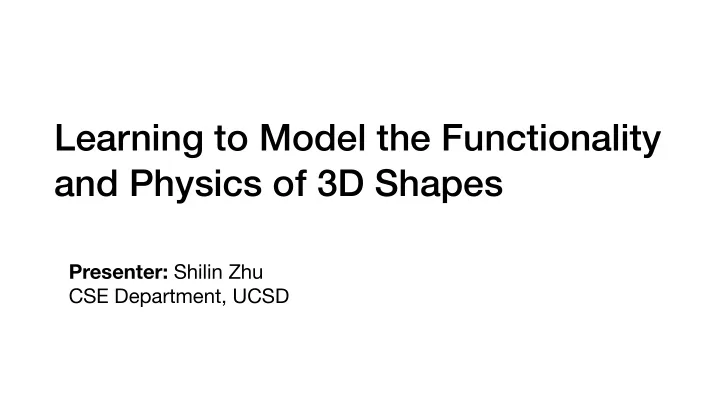

Learning to Model the Functionality and Physics of 3D Shapes Presenter: Shilin Zhu CSE Department, UCSD
Logic Flow • How to obtain the interaction context? • How to apply the forces? • How to infer physical properties?
How to obtain the interaction context? [SIGGRAPH 2018] Predictive and Generative Neural Networks for Object Functionality Ruizhen Hu, Zihao Yan, Jingwen Zhang, Oliver Van Kaick, Ariel Shamir, Hao Zhang, Hui Huang Shenzhen University, Carleton University, Simon Fraser University
Key Observations • Human can predict functionality of objects without surroundings • Experience allows to hallucinate interactions • One provides functionality and another one consumes it
What is an interaction context? • Central objects interact with surroundings that reflects functionalities • Goal: prediction and synthesis
Complete Framework • Goal: prediction and synthesis • fSIM-Net: predict functional similarity • iGEN-Net: generate interaction context • iSEG-Net: obtain individual objects and interaction types
fSIM-Net • fSIM-Net: predict functional similarity (triplet network) • Object’s latent space: GMM • Principle • (X, Y+): Push close • (X, Y-): Pull apart
iGEN-Net • iGEN-Net: generate interaction context • Two branches • Interaction context generation • Object placement
iSEG-Net • iSEG-Net: obtain individual objects and interaction types • Two branches • Segmentation on the scene context • Object placement
Results: Retrieval
Results: Multi-Functionality Synthesis
Results: Segmented Interaction Contexts
How to apply the forces? [ArXiV 2019] Learning Generalizable Physical Dynamics of 3D Rigid Objects Davis Rempe, Srinath Sridhar, He Wang, Leonida J. Guibas Stanford University
Key Observations • Human has intuitive knowledge of dynamics • The knowledge allows predicting the e ff ect of physical interactions • The dynamics should obey physics law that can generalize
One Simple Case • Predicting the rest pose after an impulse force applied on the 3D point cloud • Physics says:
One Simple Case • Input: 3D shape represented by point cloud
Model Architecture • Predicting the rest pose after an impulse force applied on the 3D point cloud
Results: Resting Pose
How to infer physical properties? [ECCV 2018] Physical Primitive Decomposition Zhijian Liu, William T. Freeman, Joshua B. Tenenbaum, Jiajun Wu MIT, Google Research
Key Observations • Human can decompose object into physical primitives • We need a physical shape representation modeling geometry and physics • The model should infer both geometrical primitive and physical parameter
What is Physical Primitive Decomposition? • It is more than geometry
What is Physical Primitive Decomposition? • It is challenging: appearance and physical motion both contribute to physical parameters (i.e., density)
Model Architecture • The model jointly combines shape, texture and motion into consideration • Classification and sampling on physical parameters leads to better results
Results: Density Estimation
Results: Analysis Confusion Matrix
Recall: Logic Flow • How to obtain the interaction context? • How to apply the forces? • How to infer physical properties?
Summary • Making machines understand interaction and physics is non-trivial • Deep neural network behaves far from human perception on dynamics • Complexity of real dynamics and functionality definition makes the problem hard to model
Recommend
More recommend